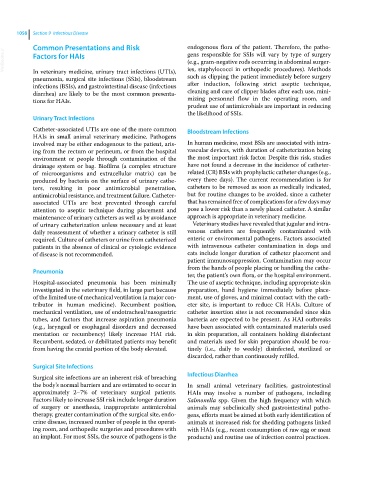Page 1120 - Clinical Small Animal Internal Medicine
P. 1120
1058 Section 9 Infectious Disease
Common Presentations and Risk endogenous flora of the patient. Therefore, the patho-
VetBooks.ir Factors for HAIs gens responsible for SSIs will vary by type of surgery
(e.g., gram‐negative rods occurring in abdominal surger-
ies, staphylococci in orthopedic procedures). Methods
In veterinary medicine, urinary tract infections (UTIs),
pneumonia, surgical site infections (SSIs), bloodstream such as clipping the patient immediately before surgery
infections (BSIs), and gastrointestinal disease (infectious after induction, following strict aseptic technique,
diarrhea) are likely to be the most common presenta- cleaning and care of clipper blades after each use, mini-
tions for HAIs. mizing personnel flow in the operating room, and
prudent use of antimicrobials are important in reducing
the likelihood of SSIs.
Urinary Tract Infections
Catheter‐associated UTIs are one of the more common Bloodstream Infections
HAIs in small animal veterinary medicine. Pathogens
involved may be either endogenous to the patient, aris- In human medicine, most BSIs are associated with intra-
ing from the rectum or perineum, or from the hospital vascular devices, with duration of catheterization being
environment or people through contamination of the the most important risk factor. Despite this risk, studies
drainage system or bag. Biofilms (a complex structure have not found a decrease in the incidence of catheter‐
of microorganisms and extracellular matrix) can be related (CR) BSIs with prophylactic catheter changes (e.g.,
produced by bacteria on the surface of urinary cathe- every three days). The current recommendation is for
ters, resulting in poor antimicrobial penetration, catheters to be removed as soon as medically indicated,
antimicrobial resistance, and treatment failure. Catheter‐ but for routine changes to be avoided, since a catheter
associated UTIs are best prevented through careful that has remained free of complications for a few days may
attention to aseptic technique during placement and pose a lower risk than a newly placed catheter. A similar
maintenance of urinary catheters as well as by avoidance approach is appropriate in veterinary medicine.
of urinary catheterization unless necessary and at least Veterinary studies have revealed that jugular and intra-
daily reassessment of whether a urinary catheter is still venous catheters are frequently contaminated with
required. Culture of catheters or urine from catheterized enteric or environmental pathogens. Factors associated
patients in the absence of clinical or cytologic evidence with intravenous catheter contamination in dogs and
of disease is not recommended. cats include longer duration of catheter placement and
patient immunosuppression. Contamination may occur
from the hands of people placing or handling the cathe-
Pneumonia
ter, the patient’s own flora, or the hospital environment.
Hospital‐associated pneumonia has been minimally The use of aseptic technique, including appropriate skin
investigated in the veterinary field, in large part because preparation, hand hygiene immediately before place-
of the limited use of mechanical ventilation (a major con- ment, use of gloves, and minimal contact with the cath-
tributor in human medicine). Recumbent position, eter site, is important to reduce CR HAIs. Culture of
mechanical ventilation, use of endotracheal/nasogastric catheter insertion sites is not recommended since skin
tubes, and factors that increase aspiration pneumonia bacteria are expected to be present. As HAI outbreaks
(e.g., laryngeal or esophageal disorders and decreased have been associated with contaminated materials used
mentation or recumbency) likely increase HAI risk. in skin preparation, all containers holding disinfectant
Recumbent, sedated, or debilitated patients may benefit and materials used for skin preparation should be rou-
from having the cranial portion of the body elevated. tinely (i.e., daily to weekly) disinfected, sterilized or
discarded, rather than continuously refilled.
Surgical Site Infections
Infectious Diarrhea
Surgical site infections are an inherent risk of breaching
the body’s normal barriers and are estimated to occur in In small animal veterinary facilities, gastrointestinal
approximately 2–7% of veterinary surgical patients. HAIs may involve a number of pathogens, including
Factors likely to increase SSI risk include longer duration Salmonella spp. Given the high frequency with which
of surgery or anesthesia, inappropriate antimicrobial animals may subclinically shed gastrointestinal patho-
therapy, greater contamination of the surgical site, endo- gens, efforts must be aimed at both early identification of
crine disease, increased number of people in the operat- animals at increased risk for shedding pathogens linked
ing room, and orthopedic surgeries and procedures with with HAIs (e.g., recent consumption of raw egg or meat
an implant. For most SSIs, the source of pathogens is the products) and routine use of infection control practices.

